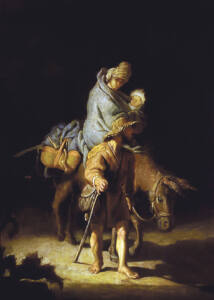
WelCom, September 2024
James B Lyons
‘I no longer believe!’ The words were shouted. And the voice was angry.
But if the statement was meant to shock me, it didn’t. I simply asked the person to tell me what they no longer believed, and the following conversation unfolded.
‘You know, all that stuff about God and Jesus. I just don’t believe it now!’
‘Why did you stop believing?’
‘I guess I grew up.’
‘Why are you telling me?’
‘I want to know why you still believe!’
I wasn’t expecting that! I was prepared to suggest ways that could help someone’s faith to return or to be rekindled, but now I was being asked to put into words what exactly supported my own faith. Why do I still believe?
We know there were times in Jesus’ ministry when he was amazed at the absence of faith among people he thought he knew.
In his hometown of Nazareth, many could not accept that someone they’d grown up with and who, like them, wasn’t particularly well educated, could possess gifts of wisdom and healing. Their antagonism – and perhaps jealousy – clouded their vision. They couldn’t see beyond appearances; they had no capacity to take in what couldn’t be seen on the surface.
The disciples panicked when a storm threatened to swamp their boat. They accused Jesus of not caring they might drown. He calmed the storm but then berated them for their lack of faith.
Jesus himself doubted, crying out in agony in the Garden of Gethsemani, My God, my God, why have you abandoned me?
Faith requires an openness to wonder and a willingness to trust. It’s bound to be shaken from time to time.
Faith involves trust, and an acceptance that I can never see or know everything as clearly as I would wish.
There are voices around us that shout down belief as foolish and totally unnecessary. Religion, we’re told, is nothing but a collection of fairytales; that the evolution of the human mind is enabling discoveries to enhance happiness and fulfilment as never before, rendering any kind of God redundant.
So why do I still believe?
The 17th century painter, Rembrandt, created many beautiful and powerful interpretations of biblical moments. Using colour, facial expressions, light and shadow, he illustrates both his admiration of faith – despite his own struggle to believe – and his appreciation of mystery which places the object of faith always just a little out of reach.
Faith involves trust, and an acceptance that I can never see or know everything as clearly as I would wish.
One small Rembrandt painting captures the Holy Family at rest during their ‘flight into Egypt’. They’re shown sheltering in a cave-like structure; the child Jesus is fanning the fire. They’re camped beside a stream; other travellers are nearby. In the safety of the hills above is a well-lit castle.
Here I saw a refugee family, strangers in unknown territory, and was amazed at their calmness.
Fleeing for their lives, with few possessions, there is, however, a tangible trust in their exposure and their vulnerability – a trust rewarded by the presence of water, the warmth of a fire and the closeness of neighbours: elements of security, refreshment and comfort.
This family still had a hard journey ahead, but here they are at peace. There’s a Hindu expression – Faith is a bird that feels the light even while the dawn is still dark. Feeling what can’t be clearly seen, they know not to be afraid.
My faith is encouraged and strengthened by these kind of images. And they’re not hard to find, especially in the lives and situations of people.
My faith is not a set of rules or dogmas that must be believed. They have a place. But faith, belief in a God who is love, is endorsed over and over by words and actions that tell me I matter, I’m loved and I’m not alone.